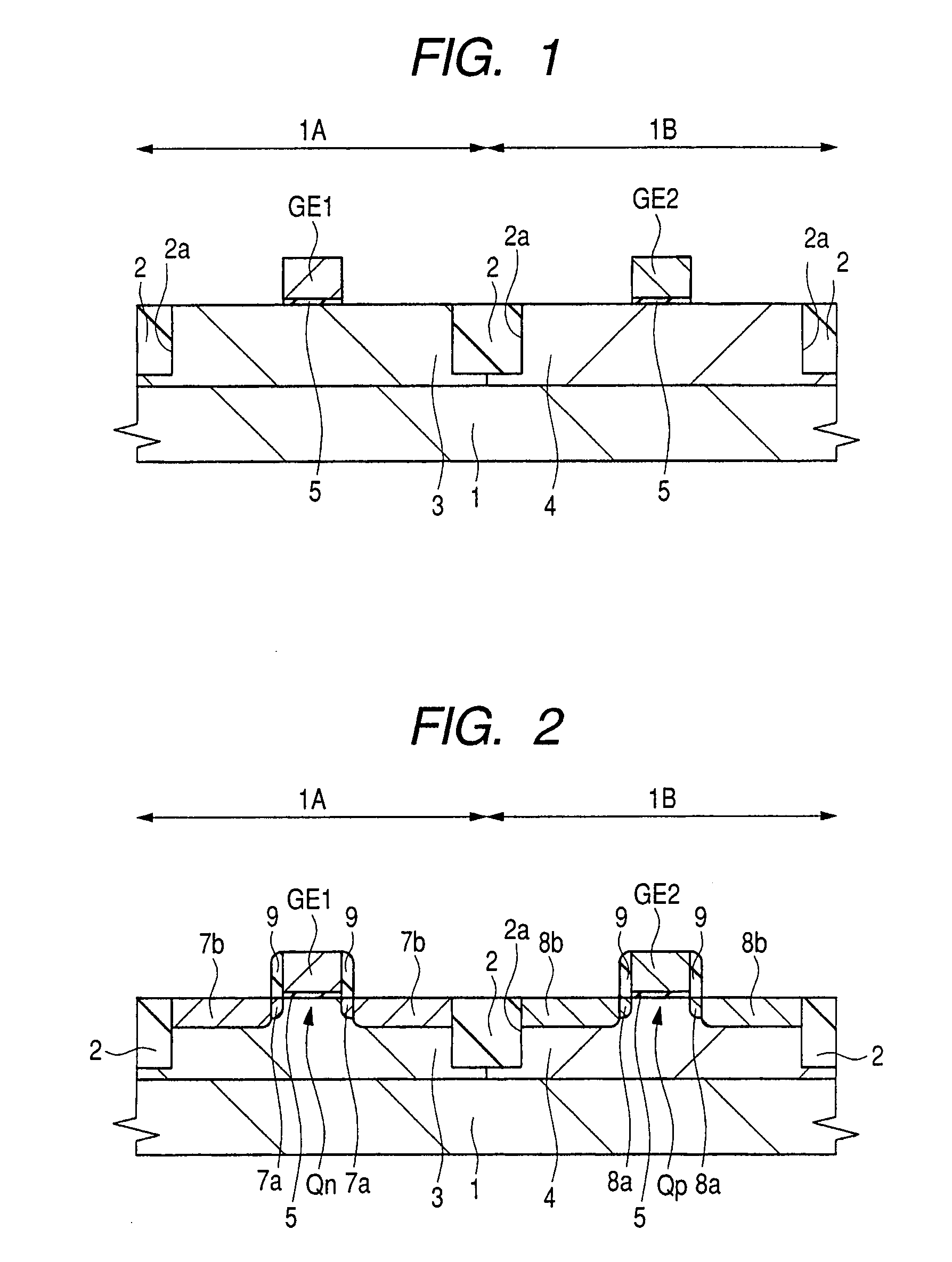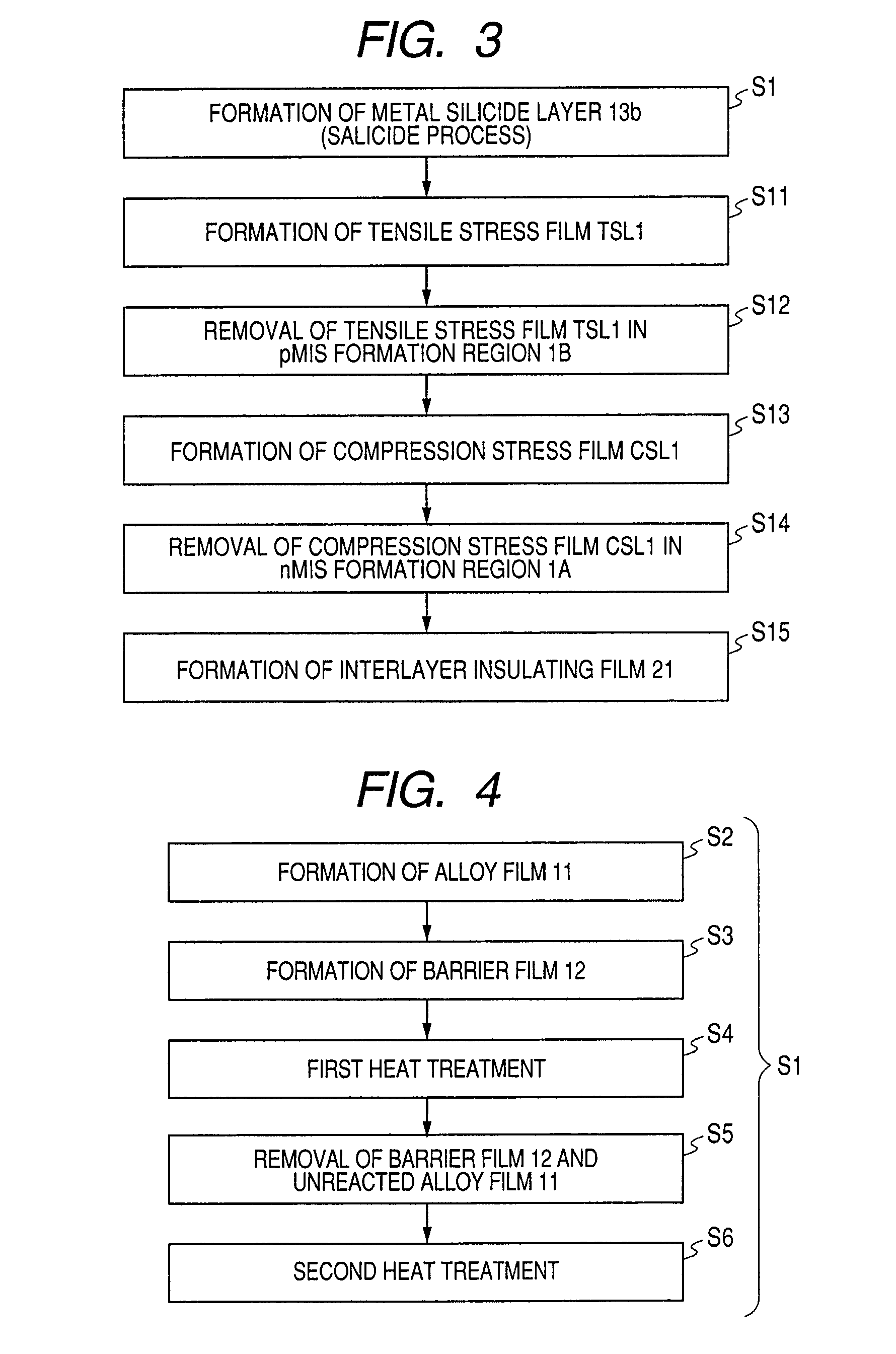Semiconductor device and method of manufacturing same
a semiconductor and device technology, applied in the direction of semiconductor devices, electrical appliances, transistors, etc., can solve the problem of increasing the cost from the standpoint of the ratio relative to the performance, and achieve the effect of improving the performance of a semiconductor devi
- Summary
- Abstract
- Description
- Claims
- Application Information
AI Technical Summary
Benefits of technology
Problems solved by technology
Method used
Image
Examples
embodiment 1
[0148]A manufacturing process of a semiconductor device of the embodiment will be described referring to drawings. FIGS. 1 and 2 are cross-sectional views of the essential part in a manufacturing process of the semiconductor device, here, the semiconductor device having a CMISFET (Complementary Metal Insulator Semiconductor Field Effect Transistor) being one embodiment of the invention.
[0149]Firstly, as shown in FIG. 1, a semiconductor substrate (a semiconductor wafer) 1 made of a p-type single crystalline silicon having a specific resistance of, for example, around 1 to 10Ω·cm, or the like, is prepared. The semiconductor substrate 1 at which a semiconductor device of the embodiment is formed has an nMIS formation region 1A being a region in which an n-channel type MISFET (Metal Insulator Semiconductor Field Effect Transistor) is to be formed, and a pMIS formation region 1B being a region in which a p-channel type MISFET is to be formed. Then, at the main face of the semiconductor s...
embodiment 2
[0217]FIG. 21 is a manufacturing process flow chart showing a part of the manufacturing process of a semiconductor device of the present embodiment, which corresponds to FIG. 3 in Embodiment 1. FIG. 22 is a cross-sectional view of the essential part in a manufacturing process of a semiconductor device of the embodiment, which shows the neighborhood of the metal silicide layer 13b of the nMIS formation region 1A and pMIS formation region 1B.
[0218]The embodiment corresponds to a first modification of Embodiment 1. The manufacturing process of a semiconductor device of the embodiment is the same as that in Embodiment 1 up to the formation of the metal silicide layer 13b at Step S1, and the description thereof is omitted here.
[0219]In the embodiment, after the formation of the metal silicide layer 13b at Step Si above (that is, after the second heat treatment at Step S6 above), the surface of the metal silicide layer 13b is oxidized (Step S21 in FIG. 21). The oxidation process at Step S...
embodiment 3
[0226]FIG. 23 is a manufacturing process flow chart showing a part of the manufacturing process of a semiconductor device of the present embodiment, which corresponds to FIG. 3 in Embodiment 1. FIGS. 24 to 28 are cross-sectional views of the essential part in a manufacturing process of a semiconductor device of the embodiment.
[0227]The embodiment corresponds to a second modification of Embodiment 1. The manufacturing process of a semiconductor device in the embodiment is the same as that in Embodiment 1 up to the formation of the tensile stress film TSL1 at Step S11 (that is, up to the obtainment of the structure in FIG. 8), and the description thereof is omitted here. Further, also in the embodiment, an oxidizing process of the surface of the metal silicide layer 13b at Step S21 may be added between the salicide process at Step S1 and the process for forming the tensile stress film TSL1 at Step S11, as in Embodiment 2.
[0228]In the embodiment, after the formation of the tensile stre...
PUM
| Property | Measurement | Unit |
|---|---|---|
| time | aaaaa | aaaaa |
| temperature | aaaaa | aaaaa |
| temperature | aaaaa | aaaaa |
Abstract
Description
Claims
Application Information
 Login to View More
Login to View More - R&D
- Intellectual Property
- Life Sciences
- Materials
- Tech Scout
- Unparalleled Data Quality
- Higher Quality Content
- 60% Fewer Hallucinations
Browse by: Latest US Patents, China's latest patents, Technical Efficacy Thesaurus, Application Domain, Technology Topic, Popular Technical Reports.
© 2025 PatSnap. All rights reserved.Legal|Privacy policy|Modern Slavery Act Transparency Statement|Sitemap|About US| Contact US: help@patsnap.com



